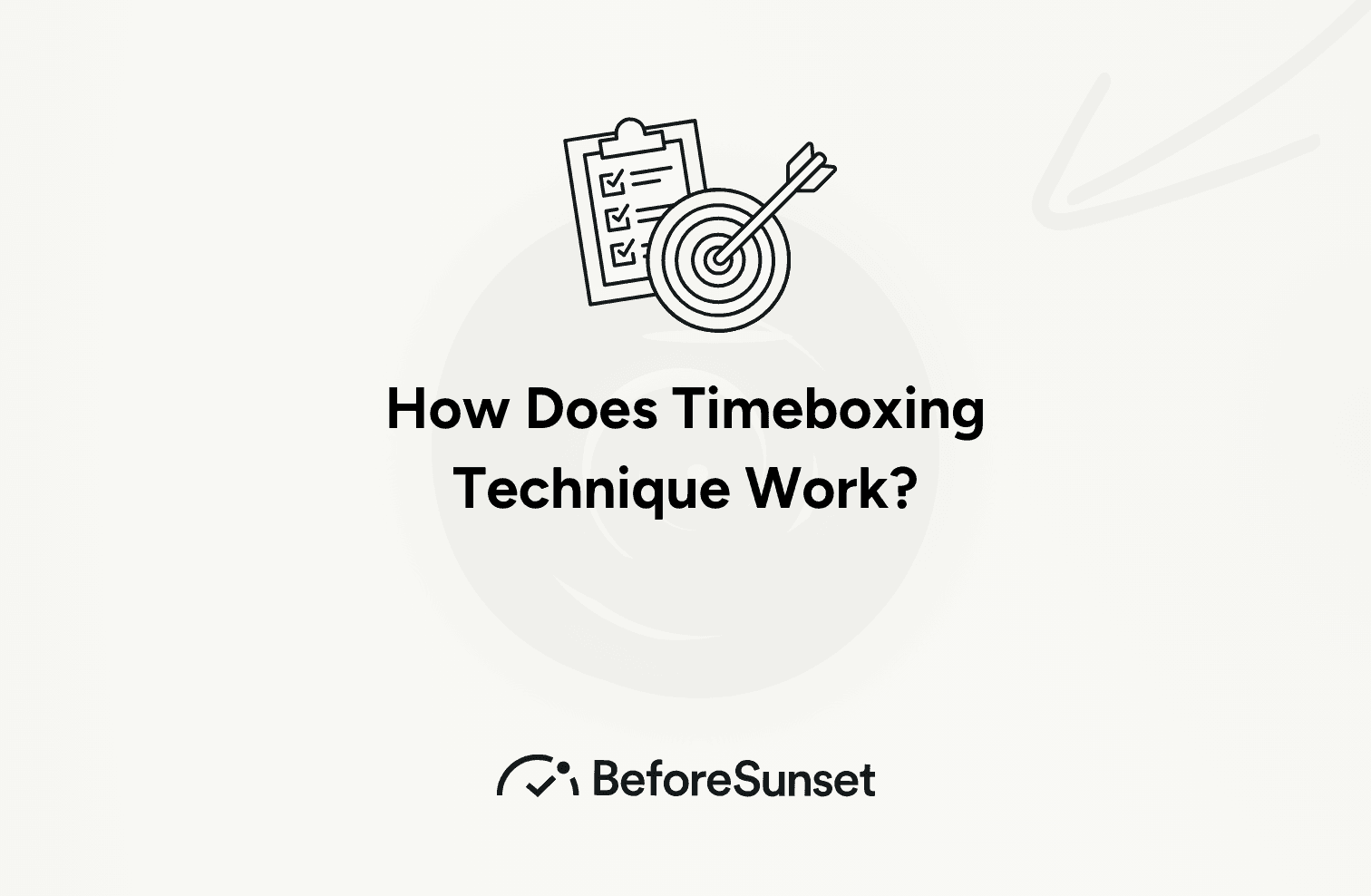We all often get the feeling that the deadlines and the tasks become too overwhelming. We think that there is a massive weight of responsibility on our shoulders because we cannot remain focused while also struggling with time.
Timeboxing as a famous time management technique offers a solution for these problems and we are here to introduce it to you through this guide!
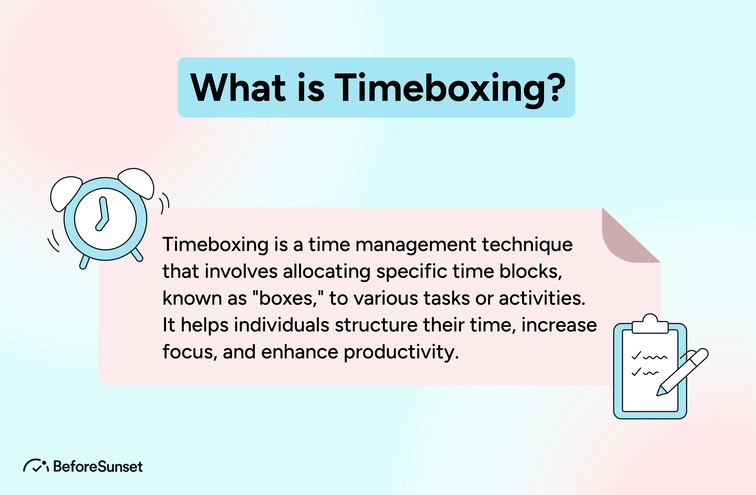
Timeboxing As a Time Management Tool?
The logic of timeboxing method is based on the ideas of "The Parkinson Law". According to Parkinson's law, a task takes as long as it does to finish it. This mindset is supported by timeboxing, which is a technique for scheduling a specific time on the calendar to complete a task.
Think about your project deadline or the times you need to prepare a presentation for your meeting to better grasp this technique. Important dates like this have deadlines that are established weeks or even months in advance.
Nevertheless, we often procrastinate and push all the work to the last day. Therefore, when we have to complete a task in a short amount of time, our stress levels rise at the same rate. The timeboxing method emerges to benefit you in your time of need.
With the help of the time management approach known as "timeboxing," you and your team can establish a specific task's completion time and then stick to it. The task need not be totally finished, but you must set a target and then assess whether it was attained.
The timeboxing method does not need to be utilized in the software development industry. You can use it to plan your own time in addition to using it for businesses and people in other professions.
How does the Timeboxing Technique Work?
To execute the timeboxing technique, firstly you should determine a precise end date for a project and work within that time frame.
You can also drop the task and go on to the next one if you are unable to complete it. Set another reasonable deadline you can meet and return to it later that day or later.
Does Timeboxing Actually Work?
Yes, timeboxing is a productive method that helps people manage their time more effectively and complete work within set deadlines. In timeboxing, a certain activity or task is given a set amount of time, and only that activity or job is focused on during that time.
The following are some benefits of timeboxing:
Increased attention: By assigning a task a deadline, you generate a sense of urgency and focus all of your efforts on finishing it by that time. This makes it easier for you to stay focused and minimizes distractions.
Increased productivity: Timeboxing promotes goal-directed labor and discourages procrastinating. It makes sure that you commit specific time blocks to each work, preventing you from falling into the trap of wasting too much time on pointless or less significant activities.
Better time management: By giving tasks definite timeslots, you have a better idea of how long various tasks take. You may arrange your day more skillfully and manage your time more effectively with this knowledge.
Improved planning and prioritization: Timeboxing pushes you to consider how long each job will take and prioritize accordingly, which leads to better planning and prioritizing. Setting attainable goals can help you avoid having a backlog of undone business at the end of the day.
Reduced stress: Timeboxing helps you approach your projects more methodically by splitting them up into smaller, more manageable pieces and assigning each one a fixed amount of time. As a result, you can feel less stressed out and like you have more control over your work.
In this method, time spans are called "timeboxes".
Their length can be ranged from 15 minutes to many months. Each time box has specific goals and dates applied to it. They can also include budgets, tasks, and achievements.
You consider your task completed at the end of the timebox, regardless of what, and then examine if you entirely or partially achieved your objectives.
To illustrate, let's say you have two tasks to do that day, so you determine how much time you need to finish each task and you set time frames. If the first is not finished within the time given, you don't keep working on it but instead, move on to the next task whether you finished the first one or not. You can schedule the first task for another time and return to it.
How Do I Start Timeboxing? (A Guide)
Take the following actions to begin timeboxing:
Choose your tasks: Make a list of the things you have to do. Divide them up into reasonable tasks that can be finished in a set amount of time.
Calculate task durations: Determine how long it will take to finish each job. If you're unsure, base this estimate on your existing knowledge or on a logical assumption.
Set time blocks: Allocate specified time blocks for each item on your agenda by setting time blocks. Based on your projected job completion times and the total amount of time you have available, choose the length of each time block.
Set your jobs' priorities: Organize your duties according to their urgency and significance. You may use this to decide which chores to complete first during your timeboxing sessions.
Eliminate distractions: Distracting factors should be minimized as much as possible throughout your timeboxing sessions. Disable notifications on your phone, shut tabs that aren't essential, and establish a concentrated workspace.
Set the clock: For the duration of your time block, set a timer. A timer on your phone or computer, a real timer, or a timer app are all possible options. As soon as the timer goes off, start working on the assignment.
Focus on the task at hand: Keep your attention on the work at hand: During the allotted time, focus only on the given task. Refrain from multitasking and commit to doing that one task in the allotted time.
Take breaks: If you have several time slots reserved, leave some space between them so you may relax and refuel. Take use of this time to unwind, stretch, or do anything to clear your thoughts.
Assess and make changes: Once the allotted time has passed, assess your performance. Great job if you finished the work in the allotted time. If not, consider why and modify your time predictions for subsequent timeboxing sessions.
Iterate and improve: As you keep timeboxing, be aware of how well it functions for you. Adapt your strategy in light of your experience, perhaps by lengthening time blocks or honing your estimating techniques.
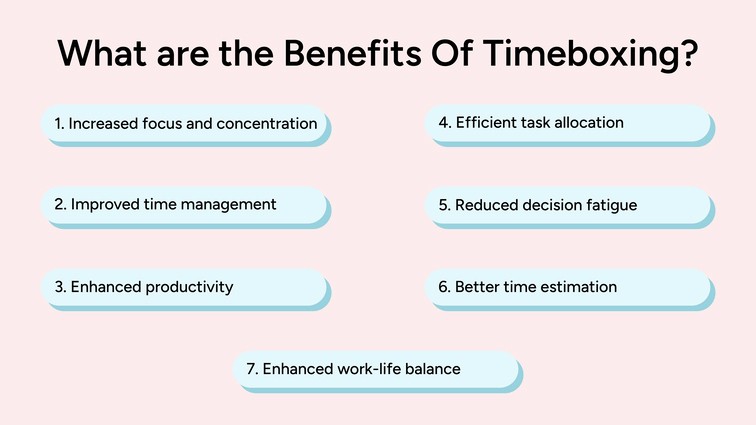
What are the Benefits Of Timeboxing?
Finding efficient methods to organize our workload and increase productivity is essential in the fast-paced world of today, when the demands on our time and attention seem never-ending. Timeboxing is one such method that is gaining popularity.
Timeboxing has emerged as a useful tool for those looking to maximize their time and get more done because to its straightforward yet effective notion of setting aside definite time blocks for particular activities.
Timeboxing is the practice of designating specific blocks of time, or "boxes," for the completion of jobs, projects, or goals. People devote all of their attention to the assigned activity during these predetermined times, minimizing interruptions and maximizing their concentration and energy.
Although the idea is simple, the advantages it provides can drastically improve both personal and professional productivity.
This essay will explore the many benefits of timeboxing and clarify how this method may improve time management abilities, increase attention and efficiency, and lower stress levels. Understanding and utilizing the power of timeboxing can enable you to reach higher levels of productivity and feel more accomplished in your tasks.
We'll talk about how timeboxing encourages more attention, higher productivity, better time management, improved planning and prioritizing, and lower levels of stress as we examine its advantages. Additionally, we will offer helpful pointers and advice to get you started with successfully integrating timeboxing into your everyday routine.
The advantages of timeboxing may be applied in a variety of situations, whether you're a student juggling coursework, a professional managing many tasks, or someone looking to maximize their free time. By implementing this time management strategy, you may improve your workflow, advance your goals, and feel more in charge and successful.
Join us on this trip as we explore the benefits of timeboxing and arm ourselves with the skills necessary to make the most of our time, sharpen our attention, and achieve more in daily life. Prepare to enter a world where productivity becomes second nature and time becomes your ally.

Timeboxing provides you control over your schedule.
It aids in completing things that you don't particularly enjoy or have put off for another reason. It also aids in task prioritization and organization and helps you be more productive.
Helps managing procrastination
It enables you to begin the work you have been meaning to start for a while but have been unable to take that crucial step. You can assess yourself and your task completion time once you've used this method for a while.
As a result, you can analyze how long it takes you to finish a task and identify the time of day when you are most productive.
Learning discipline
Along with its other benefits, the timeboxing method can help you practice self-discipline on a daily basis. Not only it boosts your productivity but also teaches you to pay less attention to unnecessary matters that keep you away from doing your tasks and not to do them if you don't want to.
Not wasting more than enough time on a project
There are some days when we are not at our best, are not as creative as usual, or are simply having a bad day. For instance, in those days, we frequently take twice as long to do tasks that would otherwise just take us 15 minutes. This is ineffective, and the results of such efforts rarely please us. Time boxing technique then saves the day.
You don't have to worry if you didn't finish your project within the time you set. You can continue doing it the following day. You'll likely be in better form by then, and the issue you were having today will be a piece of cake by then.
Having control over change of plans
The timeboxing approach gives you more control over bigger tasks. You are surely familiar with the feeling that comes when you are working on a major job and you begin to concentrate on details, perhaps even excessively.
When you immerse yourself so thoroughly in a project, you lose sight of the bigger picture and are unable to see your assignment as a whole. If you are carrying out an action that you planned yourself, there is no problem with this; you have the freedom to adjust and break from the initial plan.
Keeps teams on track
Because timeboxing keeps teams concentrated on completing the task at hand by defining done clearly, it is a popular component of many project management approaches. Additionally, timeboxing motivates teams to go to work right away.
Escaping from perfectionism
The sooner you accept that nothing will ever be perfect, the better. You can delay working on something until it's perfect by using timeboxing. Instead, it enables teams and individuals to produce effective solutions that can be expanded in successive stages.
Perfectionism that isn't necessary can result in missed deadlines, tension, and unhappy workers.
Helps with the prediction for future projects
Finding out how long it took your team to finish a project that is comparable to this one in the past can make it easier to estimate how long the next one will take by checking old timeboxes.
Additionally, it need not only apply to complete projects; it may also be relevant to individual tasks. It's inevitable that when you first start timeboxing, you'll give your team more or less time than is actually required for completion. You'll discover the ideal time frame to work within as time passes.
Enhanced Engagement of Employees
Employee involvement declines when workers believe their contribution to the project's success is not necessary. Timeboxing enables people to establish distinct priorities, which makes it simpler to understand what is most crucial. This eventually results in more projects being finished on schedule.
Employee engagement then rises dramatically as a result of feeling inspired, motivated, and driven to accomplish more and develop their abilities.
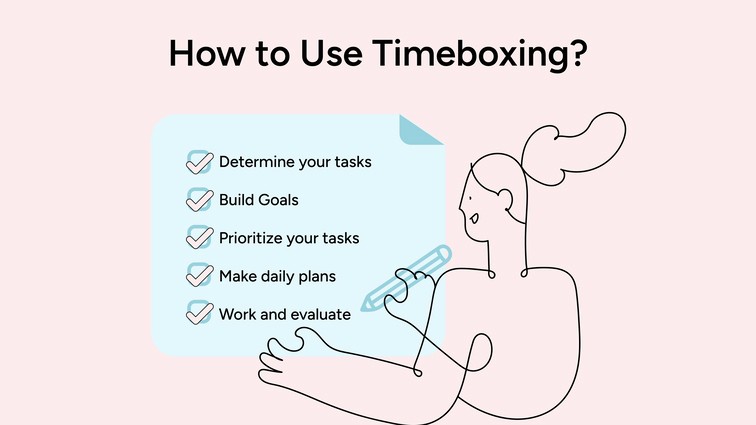
How to Use Timeboxing?
Luckily, the timeboxing method is not hard to learn and really easy to do. All you have to do is to be dedicated to your schedule and it doesn't even have to be a tight one! It is all up to you to manage your time spent on work and this method can help you to balance your work and private life especially if you work remotely or hybrid.
If you can manage to execute this technique, you can gain a lot of benefits from it. To help you to do that, we will explain it to you step by step. Let's dive in!
1. Determine your tasks.
The first thing you should do is to make a list of your tasks so you can decide which tasks need to be prioritized and see which ones you've been delaying. With the list, you can also prevent yourself from forgetting the tasks and feel more organized.
2. Building Goals
Consider what you want to accomplish by timeboxing the tasks after you've chosen them. It can be to boost initial motivation or finish the activity more quickly than usual.
Make sure the aim is crystal clear whatever it may be because you'll revisit it at the end of the day or timebox to assess it.
3. Prioritize your tasks
As soon as you've determined what your tasks are, you should measure all the available information. You should decide how long it takes to accomplish each task and its importance.
When completing this phase, you must remember to focus on crucial details like the deadline. You can complete your urgent work without procrastination until the last day by prioritizing your tasks, allowing you to relax the following day.
4. Make daily plans
Your tasks should then be organized into days and timeboxes. If your project is long-term, you can break it up into different time periods. You can begin intimidating projects in this way by taking baby steps. You'll feel better as a result and realize that there are some things you shouldn't put too much weight on.
When filling your "productivity calendar", you should also be careful not to fill every day and every space to be prepared for unexpected emergencies.
5. Work and evaluate
As the last step, you can now start working on your tasks. Don't forget not to waste your time on a task if you run out of time because decreasing the time spent on a task is the aim of the timeboxing method.
If you are working with a team, give your team time to complete each assignment, and then at the conclusion of the day, you can plan a briefing to review the day's events. Assess whether the goal was achieved by comparing the outcome to the objective.
If the assignment wasn't finished, be sure to look into what went wrong and come up with ideas for how to prevent it from happening again.
Disadvantages of timeboxing
Timeboxing may not be the best method for managing your task for everyone because you can find it challenging to pause and move to a different work when you are fully focused, therefore you can hesitate you'll lose your flow.
Additionally, you could find it challenging to follow the timetable due to frequent interruptions like telephone calls or surprise visits from coworkers or friends even your children if you are a remote working parent.
But don't worry, practice makes it better! The more you start to get used to working with timeboxing method the more you will be able to see its benefits.
Hints for Timeboxing
Take breaks
You are a human being after all. Reward yourself or your team and rest your mind after each timebox with breaks. This way, you can remain productive and be ready to work on the next timebox.
Better to set the time a little more than it needs.
Timeboxes might vary in length depending on the difficulty of the task at hand as well as any additional responsibilities your staff or you may have, so it is important to make sure to create timeboxes that would not lead to dissatisfaction, exhaustion, and missed deadlines.

The What, Why, and How of Timeboxing
What is the difference between time boxing and time blocking?
Although timeboxing and time blocking are frequently mistaken for one another, there are significant differences between the two. Both time blocking and timeboxing entail giving activities set time periods to complete.
However, To focus on a certain work or activity, time blocking requires that you set out specific time slots while timeboxing involves restricting the amount of time you spend on each activity.
Shorter time windows that you can put on your calendar that is used for time blocking are called "time blocks". They typically provide a start and finish time for an activity. Each time block is intended to serve as motivation for you to stick to your plan and complete your work on time.
At the conclusion of the time block, you evaluate whether you were able to complete the activity before the end of the allotted time, if not, you simply assign more time to the same task the following time.
What is the meaning of timeboxing in agile software development?
It's actually the same thing, just in a different field! In agile software development, a timebox is a set amount of time during which a work must be completed. Timeboxes are frequently employed to control risk in software development. Development teams are frequently given a deadline of a certain number of weeks and requested to produce a releasable update to the software.
How can you use time box for sprint planning?
The duration of the sprint is set using the timeboxing technique. The sprint is a period of time, usually lasting a month or fewer, during which a team must complete its goals. A team sets the timeframe for the Sprint Planning meeting when it debuts. For a sprint that lasts one month, the sprint planning meeting must be timeboxed at 8 hours or fewer.
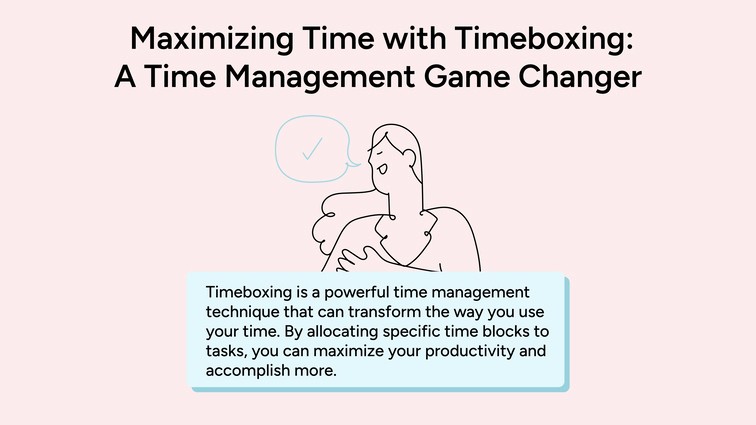
Maximizing Time with Timeboxing: A Time Management Game Changer
Making sure you use your time wisely is the goal of timeboxing. You need to give each assignment a clear deadline in order to employ this strategy. When a timebox is complete, you evaluate your performance and go on to the next one.
Timeboxing has a lot of advantages. It can assist you and your team members in overcoming analysis paralysis, reducing the propensity to procrastinate, and improving motivation when used to plan your day or while assigning work.
Timeboxing technique also enables you to assess your degree of efficiency. Using this knowledge, you may plan vital chores for when you are most productive and leave less important ones for the times when you're more likely to get distracted. In order to avoid taking on too much and running the risk of burnout, timeboxing can also help you assess whether you have sufficient free time for other assignments.
Conquer Your Day: Mastering Work with Timeboxing
Feeling overwhelmed by your to-do list? Drowning in a sea of tasks and emails? Enter time blocking, a productivity hack that can revolutionize your workday.
This technique involves dividing your schedule into chunks of time (time blocks) dedicated to single tasks. By setting time limits for each block, you harness the power of a well-known psychological phenomenon: focused work during dedicated periods leads to increased productivity.
Here's the magic: time blocking eliminates the decision fatigue of "what to do next" and minimizes distractions. You become a master of your periods of time, tackling tasks with laser focus.
Key features of time blocking include:
Planning: Block out time in advance for specific tasks.
Focus: Dedicating uninterrupted time to each activity.
Tracking time: Monitoring your progress and adjusting blocks as needed.
The result? More accomplished tasks, reduced stress, and a newfound sense of control over your workday. So, ditch the constant task-switching and embrace the power of focused work with time blocking!
What Is Alternative To Timeboxing?
Although timeboxing is a useful time management strategy, it might not be appropriate in all circumstances or for all people. There are other strategies you might try if timeboxing doesn't appeal to you or doesn't fit your unique situation well. Here are some timeboxing substitutes:
Task batching: You can bundle together jobs that are related or similar in nature and work on them in batches as opposed to designating particular time blocks for each activity. For instance, you may schedule meetings, concentrated work on particular projects, and email response time into different parts of your day. By streamlining your workflow and reducing context switching, task batching may increase productivity.
To-do lists and prioritization: This strategy entails making a prioritized to-do list where items are ranked according to their significance and urgency. Instead of setting up certain time blocks, you concentrate on doing activities in the order of importance. This allows you the freedom to do chores as you see fit while making sure that you focus on the most important ones first.,
Pomodoro Technique: Using the Pomodoro Technique, you divide your work into brief, concentrated segments called "Pomodoros," which normally last 25 minutes. These segments are separated by a brief rest. You take a lengthier break if a certain amount of Pomodoros have been completed. Working in short bursts with built-in pauses that allow for relaxation and rejuvenation helps sustain attention and productivity.
Energy management: You might change your attention from simply managing time to managing your energy levels. This method entails tracking your daily energy cycles and planning your duties accordingly. You can plan your most difficult or crucial chores for the morning, for instance, if you're more aware and concentrated then.
Flow-based work: Some people discover that they perform at their peak when they are fully engaged in a task and in a state of flow. This method prioritizes uninterrupted, in-depth work, and its goal is to get rid of distractions. Instead of placing time constraints, you concentrate on working until you reach a natural stopping point or feel accomplished.
The Easiest Timebox App: BeforeSunset AI, How to Use Timeboxing Method
Incorporating the timeboxing method into your workflow with BeforeSunset AI can significantly enhance your productivity and time management skills. Timeboxing involves allocating specific time slots or "boxes" to individual tasks or activities, helping you stay focused and organized throughout the day. Here's how you can use BeforeSunset AI to implement the timeboxing method effectively:
Planning Your Day with Timeboxes: Use BeforeSunset AI's intuitive interface to allocate dedicated time slots for each task on your to-do list. By dragging and dropping tasks into your calendar view, you can visually create your daily schedule and assign fixed durations to individual activities. AI even creates breaks between timeboxes for you. That's why we always say AI meets human touch with BeforeSunset AI.
Setting Priorities and Deadlines: BeforeSunset AI allows you to set task priorities and deadlines, helping you prioritize essential tasks and allocate appropriate time blocks for their completion. By using customizable tags and labels, you can categorize tasks based on urgency and importance, ensuring that time-sensitive activities receive adequate attention. Project managers would love it.
Implementing Focus Mode: Activate BeforeSunset AI's Focus Mode to eliminate distractions and focus solely on the task at hand during designated timeboxes. By temporarily blocking notifications and limiting access to non-essential apps or websites, you can maximize your concentration and productivity within the allocated time frame. You can access your focus time duration in the analytics section.
Tracking Time and Progress: The power of time tracking can't be denied. BeforeSunset AI's built-in time tracking feature enables you to monitor your progress and adherence to timeboxes in real-time. By recording the actual time spent on each task, you can identify inefficiencies, adjust your schedule accordingly, and make informed decisions for future planning. You can also check out our time management blog category for more personal time management methods.
Analyzing Performance and Making Adjustments: Leverage BeforeSunset AI's Daily/Weekly Analytics feature to review your timeboxing habits and evaluate your productivity levels over time. Identify patterns, trends, and areas for improvement, allowing you to refine your timeboxing strategy and optimize your workflow for greater efficiency.
By integrating the timeboxing method with BeforeSunset AI's powerful planning and scheduling capabilities, you can take control of your time, boost your productivity, and achieve your goals with confidence. Whether you're managing personal tasks or collaborating with a team, BeforeSunset AI empowers you to make the most of every minute and accomplish more in less time.

